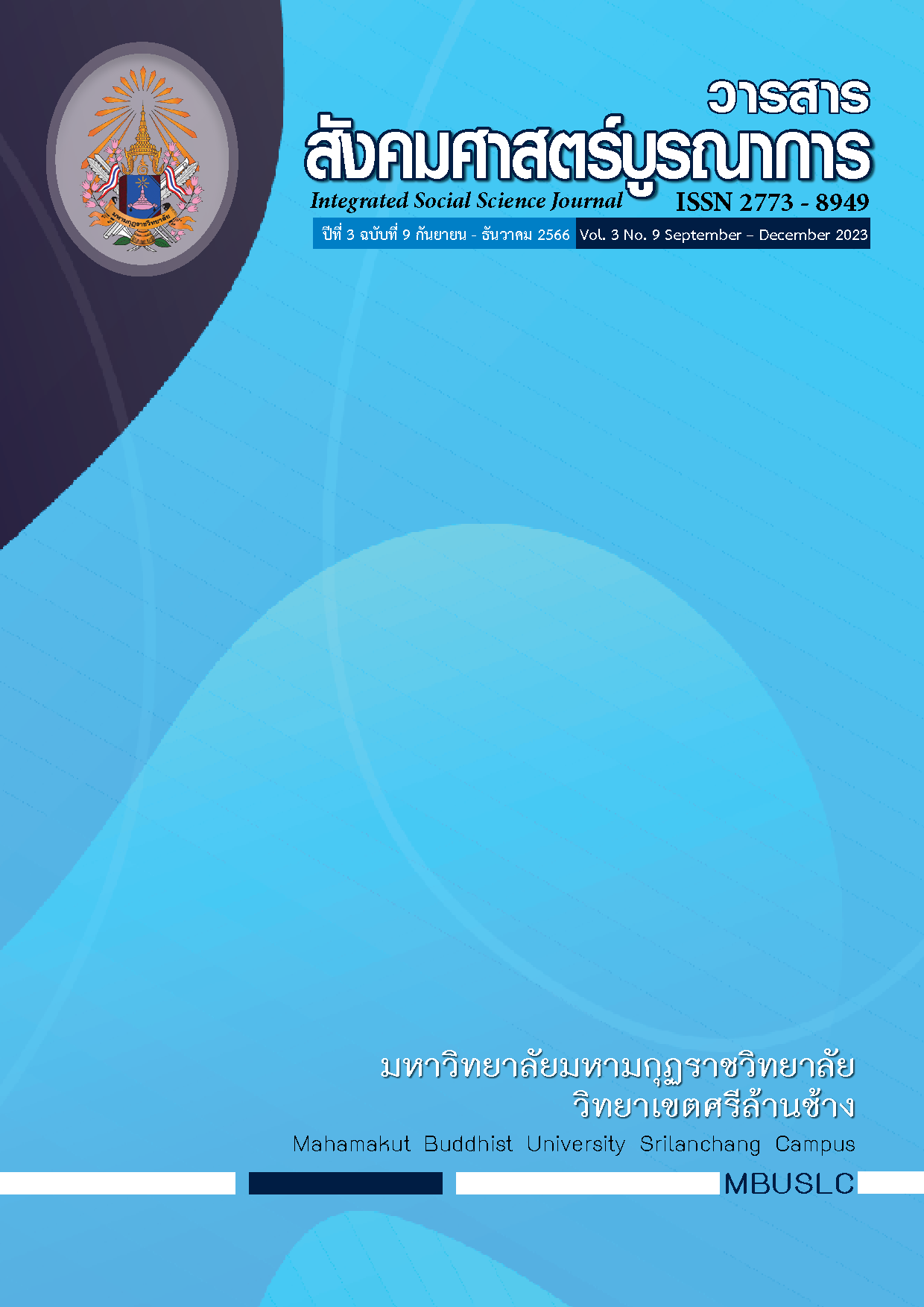ADMINISTRATION OF DIGITAL CULTURE IN SCHOOL UNDER LOEI PRIMARY EDUCATIONAL SERVICE AREA OFFICE 2
Main Article Content
Abstract
There were three objectives of the research. The first was to study the current condition, the desirable condition, and the modified priority needs index of the digital culture in schools. The sample group was a total of 389 respondents, accounting for ninety-five school administrators and 291 teachers, selected by Krejcie & Morgan's sample size calculating table, including the stratified random sampling from the school size. The research instrument was the 5-level rating scale questionnaire. The second was to study the guidelines. At this step, there were two steps; the first step on the qualitative data collection from the target group of three school administrators with the in-depth interview, and the second step on the data collection from eight experts, divided into two groups of four academic scholars and four practitioners by the multi-attribute consensus reaching (MACR). The third was to assess the guidelines for the digital culture in schools by eight experts. The qualitative data were analyzed by the descriptive analytics. The research finding revealed that the current condition was at a high level (x̅ = 4.09, S.D. = 0.65), the desirable condition was at the highest level (x̅ = 4.86, S.D. = 0.29), and the top three modified priority needs indices were as follows: the learning value with technology media (PNImodified = 0.21), the innovation practice (PNImodified = 0.20), and organizational atmosphere (PNImodified = 0.19). The other finding disclosed that the guidelines for digital culture in schools consisted of five components; 1) Learning Values with Technology Media. 2) Innovation Practices. 3) Organizational Atmosphere. 4) Digital Vision, and 5) Digital Networks. There were fifteen operational methods, fifteen practices, and fifteen successful indicators. Another finding demonstrated that assessment results of the guidelines consisted of five components, fifteen operational methods, fifteen practices, and fifteen successful indicators. The top three with the descending order of mean scores demonstrated that (1) the administrators had a way to take the technology to help solve problems in the organization with valuable projects, (2) the school had a strategy in line with the digital transformational goal, and (3) the school could operate successfully according to the given vision.
Article Details

This work is licensed under a Creative Commons Attribution-NonCommercial-NoDerivatives 4.0 International License.
บทความที่ได้รับการพิจารณาจากคณะกรรมการผู้ทรงคุณวุฒิและเผยแผ่ในวารสารฉบับนี้ เป็นทัศนคติและข้อคิดเห็นส่วนบุคคลของผู้เขียนแต่ละท่าน ไม่ถือว่าเป็นทัศนะคติและความรับผิดชอบ
ของบรรณาธิการ
บทความ ข้อมูล เนื้อหา รูปภาพ ฯลฯ ที่ได้รับการตีพิมพ์ในวารสารสังคมศาสตร์บูรณาการ ถือเป็นลิขสิทธิ์ของวารสารสังคมศาสตร์บูรณาการ หากบุคคลหรือหน่วยงานใดต้องการนำทั้งหมดหรือส่วนหนึ่งส่วนใดไปเผยแพร่ต่อหรือเพื่อกระทำการใด ๆ จะต้องได้รับอนุญาตเป็นลายลักอักษรจากวารสารสังคมศาสตร์บูรณาการ ก่อนเท่านั้น
References
โชติกา โพธ์ศรี. (2562). วัฒนธรรมองค์กรยุคดิจิทัล: นิตยสาร CAT MAGAZINE. ค้นเมื่อ 13 กันยายน 2563, จาก http://catmag.cattelecom.com/cover53/mobile/index.html
นิพัทธ์พนธ์ สุวรรณชนะ. (2561). คุณค่าของการสร้าง Digital Culture. ค้นเมื่อ 30 สิงหาคม 2563, จาก https://www.samongthailand.com/digital-leadership/
บวร ปภัสราทร. (2561). ผู้นําแบบดิจิทัล. ค้นเมื่อ 30 สิงหาคม 2563, จาก https://www.bangkokbiznews.com/blog/detail/645877
บุญชม ศรีสะอาด. (2560). การวิจัยเบื้องต้น. (พิมพ์ครั้งที่ 10). กรุงเทพฯ: สุวีริยาสาส์น.
ฟาฏินา วงศ์เลขา. (2558, 3 พฤศจิกายน). การจัดการเรียนการสอนในยุคโลกดิจิทัล. เดลินิวส์.หน้า 2.
วิไลวรรณ เรืองอุไร. (2556). แนวโน้มการใช้เทคโนโลยีเพื่อการศึกษา สำหรับสาขาวิชาเทคโนโลยีและสื่อสารการศึกษา สู่ประชาคมอาเซียน. วิทยานิพนธ์ปริญญาศึกษาศาสตรมหาบัณฑิตสาขาวิชาเทคโนโลยีและสื่อสารการศึกษา บัณฑิตวิทยาลัย มหาวิทยาลัยเทคโนโลยีราชมงคลธัญบุรี.
สมศักดิ์ วานิชยาภรณ์ และนิสรา ใจซื่อ. (2562). การขับเคลื่อนองค์การดิจิทัลเพื่อก้าวสู่การพัฒนาประเทศไทย 4.0. วารสารมนุษยศาสตร์และสังคมศาสตร์ มหาวิทยาลัยมหาสารคาม, 38(3), 78-91.
สุกัญญา แช่มช้อย. (2560). การบริหารสถานศึกษาในยุคดิจิทัล. พิษณุโลก: มหาวิทยาลัยนเรศวร.
สุวิมล ว่องวาณิช. (2558). การวิจัยประเมินความต้องการจำเป็น. กรุงเทพฯ: จุฬาลงกรณ์มหาวิทยาลัย.
สำนักงานเขตพื้นที่การศึกษาประถมศึกษาเลย เขต 2. (2564). แผนปฏิบัติการประจำปีงบประมาณ พ.ศ.2565. สืบค้นเมื่อ 5 ก.ค. 2565 จาก https://www.loei2.go.th/wp/plan-2565/
อุษา ขวัญเนตร. (2551). บรรยากาศองค์การของโรงเรียนในอำเภอแกลง สังกัดสำนักงานเขตพื้นที่การศึกษาระยอง เขต 2. งานนิพนธ์ปริญญาการศึกษามหาบัณฑิต สาขาวิชาการบริหารการศึกษา บัณฑิตวิทยาลัย มหาวิทยาลัยบูรพา.
เอกชัย กี่สุขพันธ์. (2559). การบริหารโรงเรียนยุคดิจิทัล. ค้นเมื่อ 30 กันยายน 2563, จาก https:// www.pracharathschool.go.th/skill/detail/52232
Krejcie, R.V., & D.W. Morgan. (1970). “Determining Sample Size for Research Activities”. Educational and Psychological Measurement. 30(3) : 607 – 610.
McKinsey, Q. (2017). Culture for a digital age. Retrieved September 7, 2020, from https://www.mckinsey.com/business-functions/mckinsey-digital/our-insights/culture-for-adigital-age
Swan, W. L., Langford, N., Watspn, I., & Varey, J. R. (2000). Viewing the corporate community as a knowledge network. Corporate Communication: An International Journal, 5(2), 59-75.
Wutthirong, N.D. (2007). The 7th International Conference on Diversity in Organizations, Communities and Nations. Amsterdam: [n.p.].

